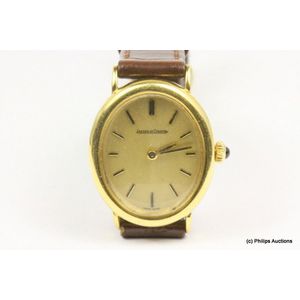18ct Gold Omega Speedmaster Chronograph Watch, 1988
You must be a subscriber, and be logged in to view price and dealer details.
Subscribe Now to view actual auction price for this item
When you subscribe, you have the option of setting the currency in which to display prices to $Au, $US, $NZ or Stg.
- Circa - A Latin term meaning 'about', often used in the antique trade to give an approximate date for the piece, usually considered to be five years on either side of the circa year. Thus, circa 1900 means the piece was made about 1900, probably between 1895 and 1905. The expression is sometimes abbreviated to c.1900.
- Chronograph - A chronograph is a watch that also incorporates the features of a stopwatch, to measure elapsed time. Most chronographs are operated by two buttons, one to start and stop the chronograph second hand, and the other to return that hand to the starting position.
- Baton Numerals - A watch that instead of displaying numerals on the face, displays a marker in the form of a baton, or lower case letter "L". Since the baton-like marks are not numerals, the feature is also called baton markers, baton indexes and baton indicators.
- Bezel - On a clock or watch, the bezel is the metal frame into which the watch or clock glass is fitted. In clocks, the bezel may include a hinge and a flange, in effect a door to the face of the clock. In jewellery the bezel is a band of metal with a projecting lip that holds the gemstone in its setting.
- Movement - The technical name for the workings of a clock or watch, and does not include the dial or case.
This item has been included into following indexes:
Visually similar items

A gold gents Omega Speedmaster wristwatch. 18ct yellow gold, Cal 1140, circa 1988, marked to dial Omega Speedmaster automatic, with 38 mm round 18ct yellow gold case, 46 jewel automatic movement, black bezel, golden dial, baton markers, three hands, three

A gents Omega Seamaster wristwatch on leather, yellow gold capped on stainless steel, marked to dial Omega automatic Seamaster, round case, silvered dial, gold baton markers, three hands, date at 3 o'clock, fitted to leather strap,

A ladies gold Jaeger Le Coultre wristwatch. 18ct yellow gold, case no 9027 .21 135 2068, circa 1960's with manual wind movement, oval case measuring 27 x 22.5 mm, with tubular polished form, golden dial with gold baton markers, two hands, fitted to a brown

A gent's Omega Seamaster wristwatch, gold plated case, 24 jewel auto movement, face distressed.
